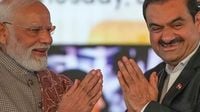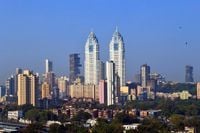On October 8, 2025, the city of Mumbai reached a major milestone in its journey as a global metropolis with the inauguration of the Navi Mumbai International Airport (NMIA), a project that has been nearly two decades in the making. The new airport, officially opened by Prime Minister Narendra Modi, marks the debut of Mumbai’s second international gateway and is poised to transform both the city’s connectivity and India’s standing on the world aviation stage.
Developed as a public-private partnership between Mumbai International Airport Limited (MIAL)—part of Adani Airport Holdings—and Maharashtra’s City and Industrial Development Corporation (CIDCO), NMIA is a testament to India’s ambitions for infrastructure-led growth. Adani Airports Holdings Limited holds a 74% stake in the airport’s managing entity, while CIDCO retains 26%. The project occupies a sprawling 1,160 hectares of land in Navi Mumbai, making it the country’s largest greenfield airport project built entirely on a new site, according to AVIONEWS.
The airport’s design, crafted by renowned Zaha Hadid Architects, draws inspiration from the lotus flower. Prime Minister Modi, in his speech at the inauguration, called the airport “a project that exemplifies the vision of a developed India,” further describing it as “a living symbol of culture and prosperity.” He added, “Mumbai is the financial capital and one of the most vibrant cities of our country. This new airport will play a key role in transforming the region into one of the most important connectivity hubs in all of Asia.”
The initial phase of NMIA is targeted to begin operations by December 2025, with a staged ramp-up to handle 20 million passengers annually. The long-term vision is even more ambitious: by the time all four runways and multiple terminals are completed, the airport aims to accommodate up to 90 million passengers per year, rivaling major international hubs like Incheon and Heathrow. Cargo operations are also central to the plan, with the first phase providing capacity for 0.5 million metric tonnes annually and eventual expansion to 3.25 million tonnes, as reported by AVIONEWS and Airport Technology.
Connectivity is one of NMIA’s standout features. The airport is integrated with a web of transportation links, including the Mumbai Trans Harbour Link, Mumbai and Navi Mumbai metro networks, suburban rail lines, and water transport routes. The Atal Setu sea bridge offers direct access from South Mumbai, while road connections extend to Thane, Pune, Raigad, and the Konkan region. Local-language coverage, as noted in regional reports, has highlighted the importance of “connectivity via water taxi, metro, and highways,” with planners emphasizing seamless access as a crucial commercial advantage.
From the outset, the airport has been envisioned as a dual-complementary system with the existing Chhatrapati Shivaji Maharaj International Airport (CSMIA), which has been straining under chronic congestion. According to Bloomberg, CSMIA is a high-intensity, single-airport system nearing its practical limits during peak hours. NMIA’s fresh terminal, new slots, and additional cargo bays are expected to alter airline behavior, encouraging carriers like IndiGo and Air India to experiment with dual-hub models and minimize the risk of missed connections between the two fields. Internationally, Middle Eastern network carriers are watching closely to see how quickly NMIA can deliver reliable slot banks during early morning and late-night waves—key periods for long-haul connectivity.
Beyond passenger volumes, cargo is a sleeper opportunity. The airport’s modern facilities, including automated cargo handling systems, a Pharma Excellence Centre with GDP-compliant cold storage, and a dedicated cargo village, are designed to attract pharmaceutical, perishable, and e-commerce shipments. The proximity to Jawaharlal Nehru Port Trust further enables integration of airport and seaport logistics, potentially lowering export costs for small and medium enterprises and connecting local farmers to global markets. As Prime Minister Modi highlighted, the infrastructure will “connect local farmers to the supermarkets of Europe and the Middle East.”
Sustainability is another pillar of the NMIA vision. The airport pledges lower emissions per passenger, with features such as passive cooling, natural lighting, on-site solar power, and a fleet of electric buses for internal transit. It will also be the first airport in India to offer a connection via water taxi, further enhancing its multimodal credentials. The operator, Adani Airport Holdings, aims to make NMIA a fully digital hub and a model of environmentally conscious and technologically advanced development.
The road to inauguration has not been smooth. The project faced significant challenges, including land acquisition, resettlement of project-affected families, and environmental constraints such as mangrove protection and river realignment. Construction only accelerated in 2022 under Adani Group management, following years of delays after the Union Cabinet’s initial approval in 2007. Even now, legal challenges, monsoon-proofing of airfield operations, and the sequencing of transport links remain on the radar. According to Bloomberg, “those issues do not disappear at inauguration,” and the true test will be how quickly the airport can hit its declared capacity.
Financially, NMIA is part of a broader cycle of airport investment in India. Earlier in 2025, Mumbai International Airport Ltd secured a $750 million investment-grade financing deal with Apollo Asset Management and other long-term investors. This transaction included funds earmarked for expansion and decarbonization commitments toward a 2029 target. The airport’s returns will be shaped by tariff cycles set by India’s Airports Economic Regulatory Authority, which balances aeronautical charges and non-aeronautical revenues under hybrid-till frameworks. Non-aeronautical revenue streams—retail, food and beverage outlets, duty-free shopping, advertising, lounges, and real estate development—are critical for debt service and long-term profitability.
The market’s reaction to the grand opening was notably muted. Equities in Mumbai barely budged, with infrastructure and capital goods sectors seeing only marginal gains, while airline shares remained largely unchanged. As Bloomberg observed, “aviation-linked names in India tend to move more on fares, fuel, and fleet orders than ribbon cuttings.” The cautious optimism reflects skepticism about execution timelines rather than doubts about demand.
Looking ahead, the success of Mumbai’s two-airport system will hinge on unified slot coordination, integrated surface transport ticketing, and seamless inter-airport transfers. These elements will determine whether the city can unlock true network effects or risk stranding capacity. The competitive landscape is also shifting: Chinese media have noted that India’s expanding airport infrastructure could chip away at Gulf hub dominance, but only if Indian carriers invest in widebody fleets and maintain high standards of on-time performance.
As Asia’s other major hubs have shown, becoming a world-class gateway requires more than just construction—it demands disciplined governance, smart partnerships, and a relentless focus on execution. For Mumbai, the opening of NMIA is not just a ribbon-cutting moment, but the beginning of a new chapter in the city’s—and India’s—global journey.






